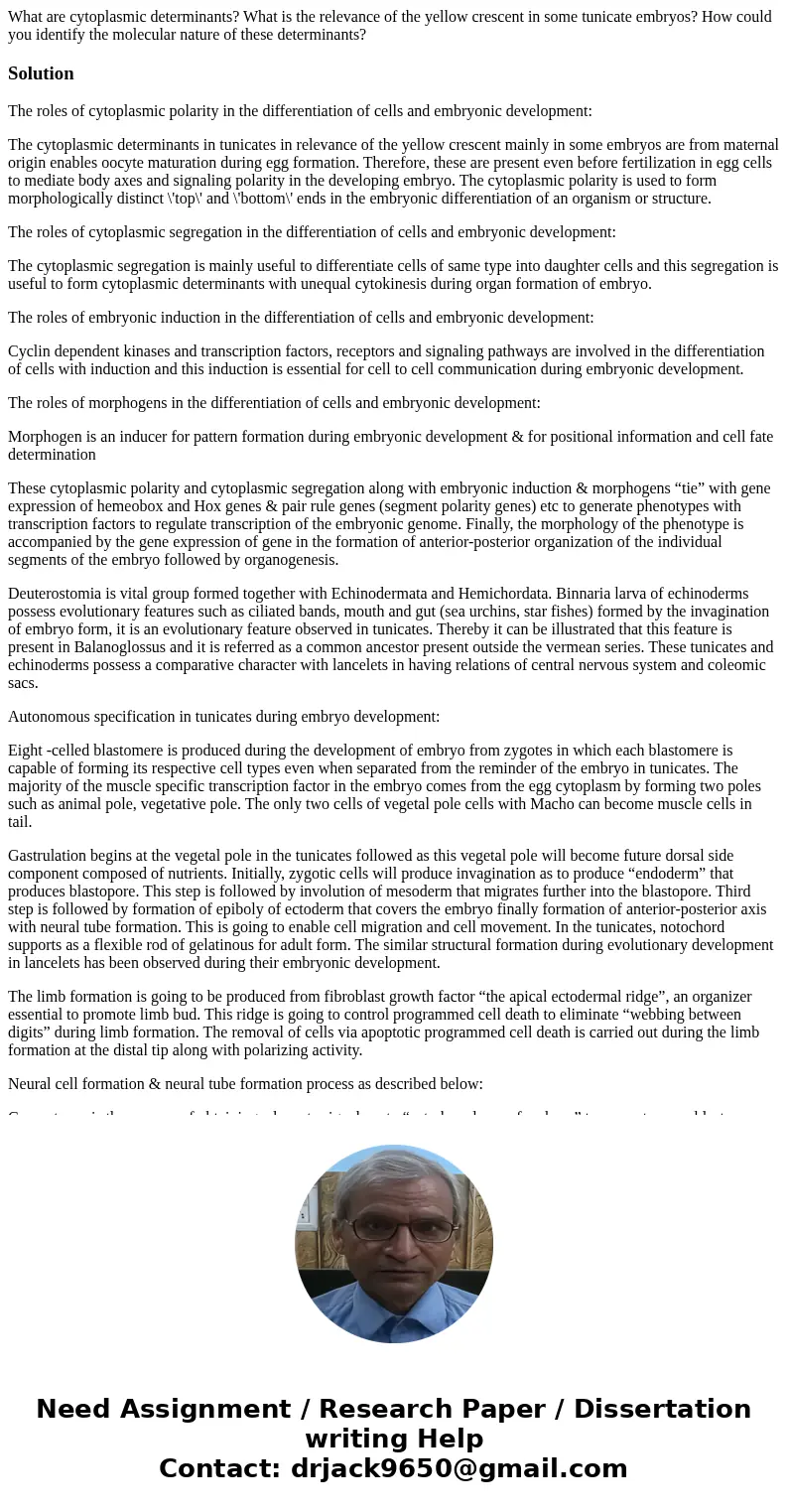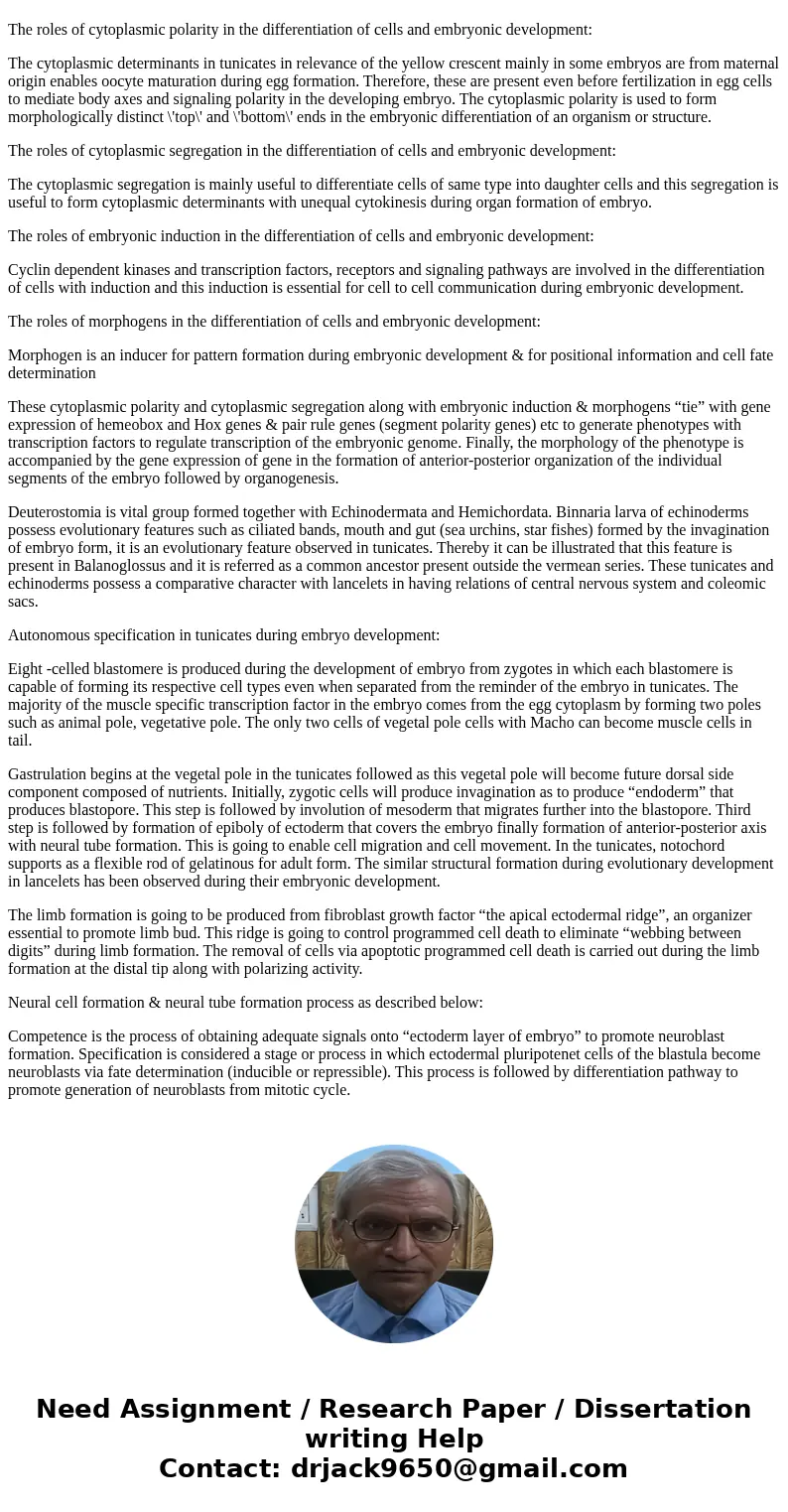What are cytoplasmic determinants What is the relevance of t
What are cytoplasmic determinants? What is the relevance of the yellow crescent in some tunicate embryos? How could you identify the molecular nature of these determinants?
Solution
The roles of cytoplasmic polarity in the differentiation of cells and embryonic development:
The cytoplasmic determinants in tunicates in relevance of the yellow crescent mainly in some embryos are from maternal origin enables oocyte maturation during egg formation. Therefore, these are present even before fertilization in egg cells to mediate body axes and signaling polarity in the developing embryo. The cytoplasmic polarity is used to form morphologically distinct \'top\' and \'bottom\' ends in the embryonic differentiation of an organism or structure.
The roles of cytoplasmic segregation in the differentiation of cells and embryonic development:
The cytoplasmic segregation is mainly useful to differentiate cells of same type into daughter cells and this segregation is useful to form cytoplasmic determinants with unequal cytokinesis during organ formation of embryo.
The roles of embryonic induction in the differentiation of cells and embryonic development:
Cyclin dependent kinases and transcription factors, receptors and signaling pathways are involved in the differentiation of cells with induction and this induction is essential for cell to cell communication during embryonic development.
The roles of morphogens in the differentiation of cells and embryonic development:
Morphogen is an inducer for pattern formation during embryonic development & for positional information and cell fate determination
These cytoplasmic polarity and cytoplasmic segregation along with embryonic induction & morphogens “tie” with gene expression of hemeobox and Hox genes & pair rule genes (segment polarity genes) etc to generate phenotypes with transcription factors to regulate transcription of the embryonic genome. Finally, the morphology of the phenotype is accompanied by the gene expression of gene in the formation of anterior-posterior organization of the individual segments of the embryo followed by organogenesis.
Deuterostomia is vital group formed together with Echinodermata and Hemichordata. Binnaria larva of echinoderms possess evolutionary features such as ciliated bands, mouth and gut (sea urchins, star fishes) formed by the invagination of embryo form, it is an evolutionary feature observed in tunicates. Thereby it can be illustrated that this feature is present in Balanoglossus and it is referred as a common ancestor present outside the vermean series. These tunicates and echinoderms possess a comparative character with lancelets in having relations of central nervous system and coleomic sacs.
Autonomous specification in tunicates during embryo development:
Eight -celled blastomere is produced during the development of embryo from zygotes in which each blastomere is capable of forming its respective cell types even when separated from the reminder of the embryo in tunicates. The majority of the muscle specific transcription factor in the embryo comes from the egg cytoplasm by forming two poles such as animal pole, vegetative pole. The only two cells of vegetal pole cells with Macho can become muscle cells in tail.
Gastrulation begins at the vegetal pole in the tunicates followed as this vegetal pole will become future dorsal side component composed of nutrients. Initially, zygotic cells will produce invagination as to produce “endoderm” that produces blastopore. This step is followed by involution of mesoderm that migrates further into the blastopore. Third step is followed by formation of epiboly of ectoderm that covers the embryo finally formation of anterior-posterior axis with neural tube formation. This is going to enable cell migration and cell movement. In the tunicates, notochord supports as a flexible rod of gelatinous for adult form. The similar structural formation during evolutionary development in lancelets has been observed during their embryonic development.
The limb formation is going to be produced from fibroblast growth factor “the apical ectodermal ridge”, an organizer essential to promote limb bud. This ridge is going to control programmed cell death to eliminate “webbing between digits” during limb formation. The removal of cells via apoptotic programmed cell death is carried out during the limb formation at the distal tip along with polarizing activity.
Neural cell formation & neural tube formation process as described below:
Competence is the process of obtaining adequate signals onto “ectoderm layer of embryo” to promote neuroblast formation. Specification is considered a stage or process in which ectodermal pluripotenet cells of the blastula become neuroblasts via fate determination (inducible or repressible). This process is followed by differentiation pathway to promote generation of neuroblasts from mitotic cycle.


 Homework Sourse
Homework Sourse